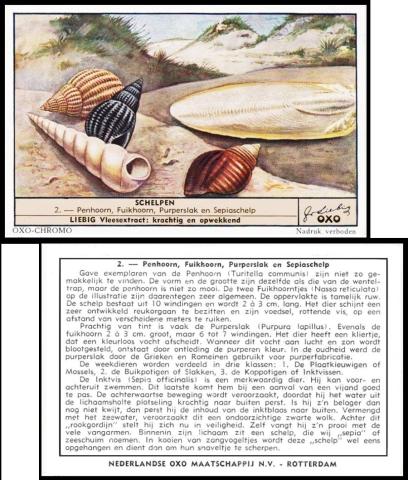
The shells shown here are the Penhoorn (Auger Shell), Fuikhoorn (Nasarius?), Purperslak (Dog Whelk) and Sepiaschelp (Cuttlefish)
This is a curious set, because it is identical to the Liebig set issued in 1950, catalogued as S.1489 or F.1489, and titled "Shells of Our Sea Shore" (1950) - or in Dutch "Schelpen van ons Kust" - or in French "Coquillages de Notre Littoral". However if you look closely at our card the title is just "Schelpen", and, in the box in the bottom right hand corner, beneath the Liebig signature, there is an "OXO".
Liebig was founded in 1856 by a man called Justus von Liebig, who developed a way to make concentrated meat extract. In England it was called LEMCO, which came from the initials of Liebig Extract [of] Meat Company. The first cards were issued in 1872, a black and white set of sixteen cards called "Vue des Fabriques à Fray Bentos" (Views of the Fray Bentos Factory). OXO came along in 1899, it was a liquid, and quite expensive, but Liebig knew that those who could least afford it needed it most, to make their children strong and healthy, and so he set about a way to make it cheaper without reducing the nourishment. It took a while but in 1910 he was able to offer the first cubes of OXO that worked out at a penny each.
If anyone can supply us some facts about these Liebig OXO cards, we would be most interested - there must have been others too but when did they start, and end ?
We do know that in 1934, OXO issued a set of cards entitled "British Cattle", so I will have a look at those later today in the trade indexes, and see if they give any clues.
